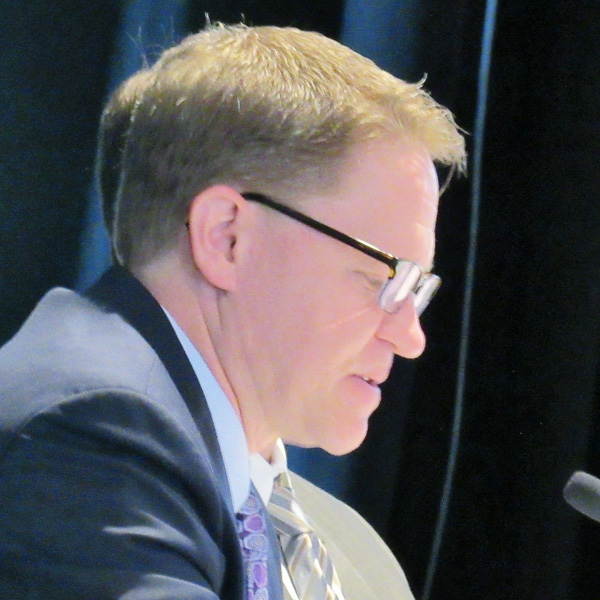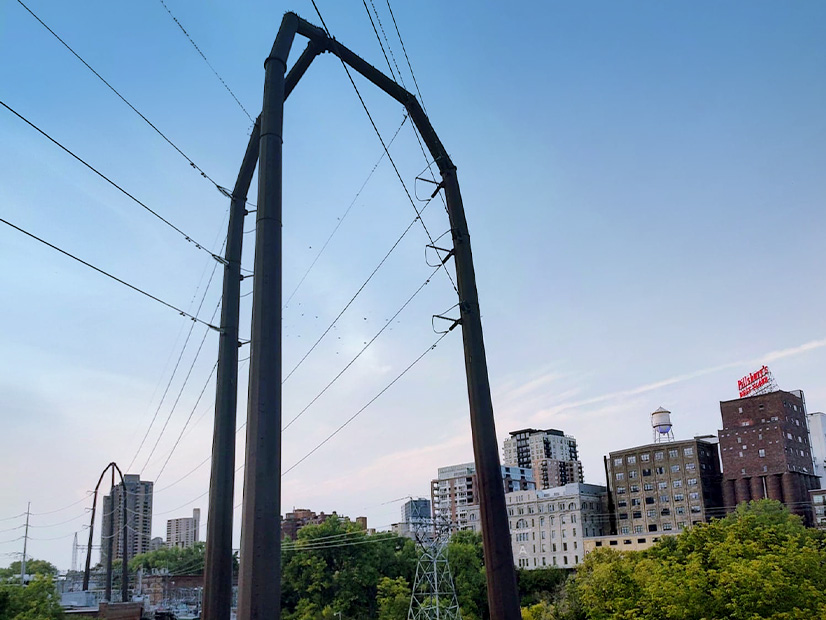MINNEAPOLIS — MISO, its market monitor and members debated the best course to implement ambient-adjusted line ratings during a Sept. 15 Advisory Committee meeting.
The Independent Market Monitor and some members endorsed widespread adoption before FERC’s Order 881 takes effect in 2025, while transmission owners advocated a more restrained introduction.
Renuka Chatterjee, vice president of operations, said the key terms in formulating ratings are “push” and “safe.”
“We want to push our system to its limits, but we want to keep it safe,” she said.
 MISO VP Renuka Chatterjee | © RTO Insider LLC
MISO VP Renuka Chatterjee | © RTO Insider LLCChatterjee reminded the membership that the Northeast’s massive blackout of 2003 initially began with power lines in northern Ohio drooping into trees and tripping circuit breakers.
MISO says that universal use of ambient-adjusted ratings (AARs) in conjunction with strategic transmission reconfigurations “will only locally and marginally decrease congestion.” It said the billions worth of transmission projects identified under MISO’s long-range transmission plan (LRTP) and its Joint Targeted Interconnection Queue study with SPP are better positioned to “substantially” reduce congestion.
Only 12% of MISO’s transmission facilities use the AAR mechanism.
“Now, you can conclude that 88% of lines need work, but not all of these are congested lines,” Chatterjee said.
But the IMM’s David Patton said MISO should have “full utilization of the system first” before it builds out transmission facilities.
Patton said that since the fall of 2021, MISO has achieved $34 million in savings by using AARs on 65 constraints. But he said the RTO and its transmission owners have left $282 million in possible savings on the table by not deploying AARs on all constraints. He said had MISO used two- to-four-hour emergency line ratings in the footprint, it could have saved $179 million since last fall.
 MISO IMM David Patton | © RTO Insider LLC
MISO IMM David Patton | © RTO Insider LLCPatton said binding transmission constraints with overly conservative ratings can strand generation and keep MISO from accessing the full range of its reserves.
Some members asked TOs to install AAR programs before Order 881’s compliance deadline.
Clean Grid Alliance’s Natalie McIntire pointed out that the first batch of LRTP lines aren’t expected to be in service until 2028 and 2030. She said in the meantime, MISO can use AARs and dynamic line ratings (DLRs) to get the most out of its transmission system. She said more precisely calibrated ratings will ease the system congestion caused by wind production in the footprint’s northern region and might allow for more wind generation interconnections.
Michigan Public Service Commission Chairman Dan Scripps said DLRs and AARs can help avert load shed during extreme weather events and when generation is scarce.
“We’re not going to eliminate congestion. We can reduce it through AARs … but it’s not the end-all and be-all,” ITC’s Cynthia Crane said.
Crane said the MISO footprint will likely benefit from AARs in the spring and fall shoulder seasons and in the mornings and at night, when temperatures are cooler.
“Unfortunately, we’re not going to see much benefit from AARs during the summer or during heat waves,” she said.
Otter Tail Power’s Stacie Hebert, a MISO transmission owners representative, likened standing up AAR programs to complex undertakings such as the grid operator’s market platform replacement or its long-term transmission planning.
“Some things just take as long as they do to get them done,” Hebert said.
Crane said AAR programs mean that TOs will have to overhaul software to maintain databases with millions of entries that change hourly.
“From our standpoint, three years feels like tomorrow,” she said of Order 881’s compliance deadline.
Hebert said the most congested transmission elements are usually transformers, which FERC has ordered TOs to review. She said TOs are carefully maintaining transformers because hobbled supply chains are making them increasingly difficult to replace.
“We’re not looking to put additional risk to our transformers at this time in this current environment,” she said, noting TOs don’t have their normal stockpiles of spare transformers.
Hebert said that although TOs agree there are savings to be had, she disagrees with Patton’s figures.
“In order to make that estimate for the footprint, he had to make some assumptions, and he doesn’t have access to that information,” she said.
Hebert said she didn’t see how Patton could factor in the next limiting transmission element in his ratings saving calculation. She said line ratings have been underscored lately because of big-ticket and possibly overblown savings being estimated.
Multiple MISO TO representatives said estimating AAR savings is moot because they will have to implement AARs anyway.
Some Advisory Committee members said MISO and TOs conducting closed-door meetings of its Reconfiguration for Congestion Cost Task Team (RCCTT) doesn’t inspire trust that TOs are making decisions with everyone’s best interest in mind. MISO and TOs say the confidential sessions are necessary because the group discusses critical infrastructure.
The nonpublic RCCTT has met since last year and focuses on rerouting transmission flows during times of heavy congestion costs. It maintains a monthly list of the top congested constraints within the footprint.




